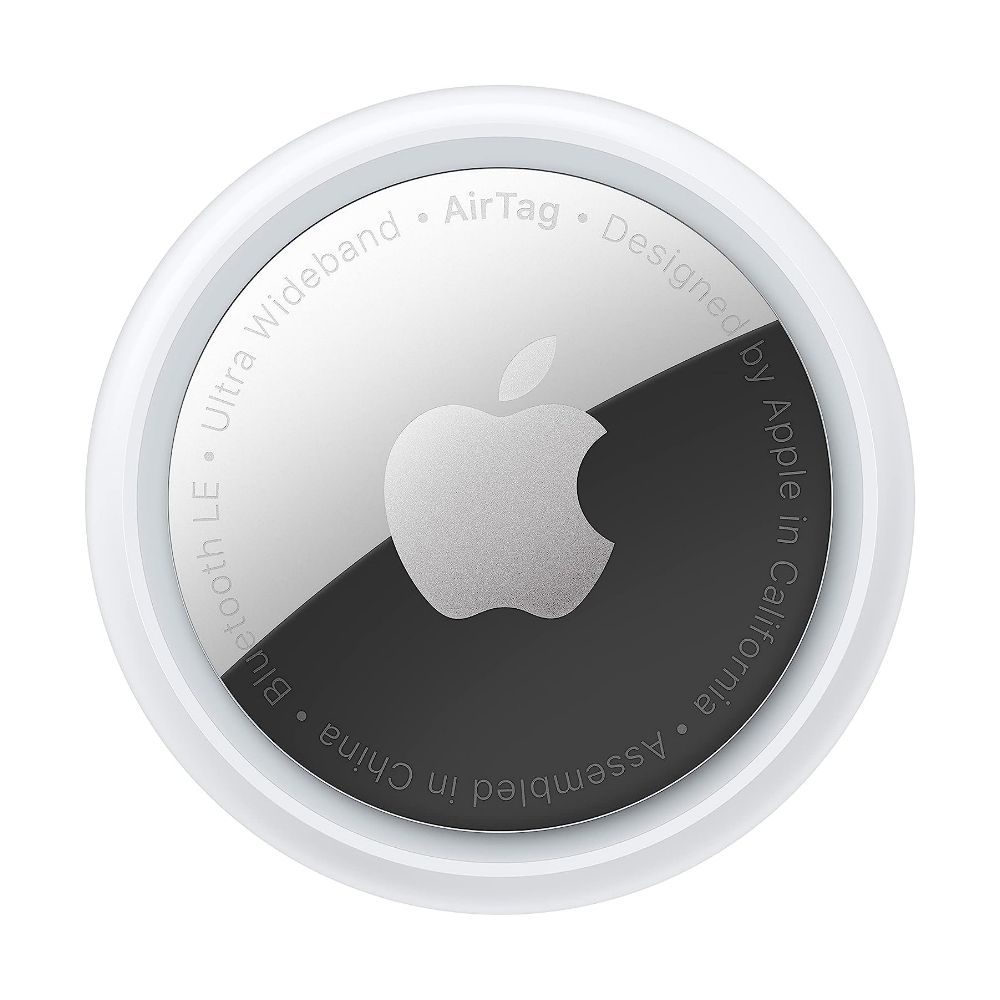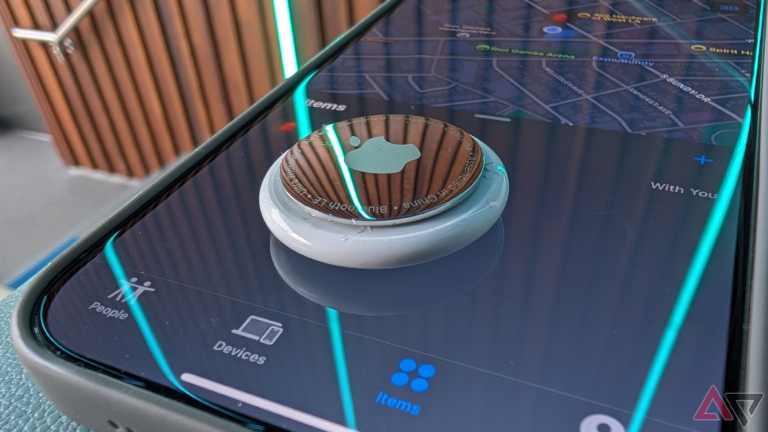Apple says their Find My network comprises “hundreds of millions of iPhone, iPad, and Mac devices around the world” and that is the strength of the Apple AirTag – along with their robust, relatively frictionless, ecosystem. While Google Keep and Reminders apps help you with things you write down that you may need to remember, AirTags are silver dollar-sized trackers that help you keep up with the things you don’t write down, like checked luggage, a makeup kit, or car and house keys.
The Apple AirTag is so good that we need Google to make its own version. As many devices as Google Maps and other Google apps are on, that could make delightfully colored Google “AirTags” the only real competitor for Apple. I’ll explain what makes an Apple AirTag great.

Apple AirTag
$24 $29 Save
$5
If you’re in the Apple ecosystem, the Apple AirTag is the best Bluetooth tracker you can buy. If you’re an Android owner, you’ll want to look elsewhere.
- Easy setup
- IP67 water resistance
- Large accessories market
- Find My app is easy to use
- Precision Finding works reliably
- Apple only
- Easily blemished
- Can?t ping your phone from the AirTag
Price, availability, and specs
Apple AirTags can be purchased individually for $29 or $99 for a four-pack. They are available in just one two-tone color: a silver front cover with a white body. You can purchase them on Amazon, or directly from Apple’s website. You can also pick them up in-store at Apple, as well as at places like Best Buy, Target, and Walmart.
Specifications
- Connectivity
-
Bluetooth LE, Ultra Wideband, NFC
- Battery
-
Up to one year, user-replaceable CR2032 coin cell battery
- Range
-
Up to 30m (100 feet)
- Water Resistance
-
IP67
What’s good about the Apple AirTag?
Crowdsourced sleuthing
I can’t discuss an Apple product like this without beginning with the ecosystem and user base. When I first reviewed Tile’s products, I really liked them, but my primary issue was adoption. To be useful, a lot of people needed to buy them. That is a problem Apple doesn’t have. According to Cupertino, their Find My crowdsourced network is a billion devices strong globally, making the odds of finding your lost item stronger than some of its tracker competitors.
In terms of the ecosystem, Apple AirTags are compatible with iPhones and iPads, but the Find My app can be accessed from multiple places. During my testing, I was out for a run without my phone, and my Apple Watch notified me that I’d left my backpack behind. That’s where I kept the AirTag during testing, naming it “Tshaka’s Backpack” during the simple setup process.
Once you get the small, shiny AirTag unboxed, you just hold it up to your iPhone or iPad, and it will automatically be detected. Once I scrolled through the list of options of what the tag would be “attached” to, and named it “Tshaka’s Backpack,” the Find My app began tracking. One of the things that makes the AirTag a great gadget is Precision Finding, which utilizes the U1 chip in an iPhone 11 or newer and the ultra-wideband tech in the tag to provide animations and directional arrows pointing the way to “Tshaka’s Backpack” when I was within around 10 meters or 30 feet from the AirTag.
At that time, the tag was outside my backpack. I was testing it on a table behind some items, so I couldn’t see it despite the arrow. That’s when I hit the speaker icon to ring it, so I could find it, which worked quite well. The downside is that the sound the AirTag emits isn’t that loud. It was fine for me because it was out in the open. But when I placed it between the couch cushions, it was barely audible from 30 feet in another room.
If you have a common family item, like a pair of car keys that the teen drivers in your home might access, you can share the AirTag attached to the keys with up to five people, beginning in iOS 17. In iOS 18, Apple takes that further by allowing a sharing link with a third party, like your airline, when you lose luggage. Or, maybe you’ll share it with a trusted person, so they’ll also be notified when that forgotten or lost item is recovered.
That shared link will be disabled once the owner is reunited with the lost item, and it can be disabled from your iPhone at any time. For the sake of privacy, the link expires after seven days. There’s also no need to worry about a dead AirTag because Apple says the CR2032 coin cell battery it uses will last for about a year.
AirTags and Find My rely on Apple’s extensive device network, but Android devices can also detect tags via Apple’s Tracker Detect Android app — it’s been downloaded over a million times on Google Play.
When activating Lost Mode, you can add a phone number or email and a brief message to the Help Message connected to Lost Mode. An Android user who finds an AirTag in Lost Mode can tap the device on their phone. The phone, activated by NFC, will open a webpage with the user’s pre-populated info and the AirTag’s serial number. I placed my AirTag in Lost Mode and used my Pixel 9, which doesn’t have Tracker Detect, and picked up, tapped it, and identified the owner of the “lost” tag.
In my daily use, if I left my backpack at home or went to the gym on my lunch break and left the backpack at work, it took eight to ten minutes to get an alert that I’d left it behind. One of the best parts of the Apple ecosystem is that my LTE-enabled watch doesn’t need to be connected to my phone for the Find My network to do its job. Speaking of ecosystems, you can also use Siri to help locate misplaced items by saying, “Hey Siri, find Tshaka’s Backpack,” or whatever you’ve named yours. Since I also selected the location of the AirTag as “backpack” when setting up, I can also just say, “Hey Siri, find my backpack.”
I work in an industry with celebrities and on-air personalities, so I’m aware that stalking is a genuine concern for some people. Even for those who wouldn’t be considered “famous.” So, it’s hard for me to say if this goes far enough for you. But what Apple does to keep you safe is use rotating Bluetooth IDs, so it’s very difficult for someone to connect the device name with the ID. And if someone throws an AirTag in your car, under the seat, or tries to hide it in a personal belonging, the network notices it’s with you and will send an alert to your phone. After some time, 8 to 24 hours, if you haven’t located it, the AirTag will chirp once so you can find it. According to Apple, all your location data or personal identifiers are encrypted throughout the process.
Apple goes into great detail about privacy and what to do if you think you’re being tracked on the support page. Now, I know that having a Google version would definitely raise some eyebrows given some of the trouble Google has been in regarding privacy issues. If they follow Apple’s lead — they did with making AirTags detectable on Android — I think folks’ primary concerns would likely be addressed. That’s a tough nut to crack because part of the problem with Google’s current Find My Device network is the multiple ways users can opt out of its features. Its greatest privacy strength could also be its greatest tracker weakness.
What’s bad about the Apple AirTag?
They’re too simple
The simple silver and white disc inside the box has no lanyard opening or attachment points, so you’ll need to spend more money to attach it to something like a set of keys. Since this is an Apple product, there is no shortage of accessories for AirTags and the third-party market is booming. But, again, you’ll need to factor the cost of an accessory or accessories into that $29 or $99 price tag.
An AirTag relies solely on Bluetooth and NFCl, so it isn’t a GPS tracker. That means it needs to be within 10 meters/30 feet of an iPhone/iPad/Apple Watch for a location fix. So, the user is reliant on population density for efficacy; if you live in an area with no neighbors for a mile, don’t lose that tracked item.
The silver cover is thin, slick, and easily scratched, but the white part that holds the coin cell battery is thick. So it won’t fit in many wallets without creating a noticeable bulge. Thinner trackers are on the market, so you’ll want to look elsewhere if you need something in a thin wallet.

Read our review
Should you buy it?
Only if they’re Made By Google
If you’re an iPhone/iPad/Apple Watch owner, as with most things Apple, AirTags just work inside the ecosystem. Sure,
Tile makes some slimmer trackers
if you need one for your wallet but they don’t have the network that Find My does. According to Tile, that network is 70 million strong. To be fair, Apple states that its Find My network of human beings is actually in the hundreds of millions, in contrast to its network of a billion devices. That said, if you’re an Android user not using a Samsung Galaxy device, Tile may be the way to go.
You could also choose a Samsung SmartTag2, but that also means having a Samsung Galaxy phone or tablet, like AirTags and Apple devices. It has many of the same features as AirTags with their version of Precision Finding, and even longer battery life at 500 days as opposed to 365.
Ultimately, I’d love to see Google (with the size of their install base) create their own version of the Apple AirTag, but make it Google-y. Give it to me in more than just white. Let’s go with the current Pixel Buds Pro 2 colors of peony, wintergreen, and porcelain. I can’t wait to connect a Pocket Pixel to items and track them from my Pixel phone, Pixel Watch, and tablet. Actually, pause; I can wait, and allow Google time to improve Android’s Find My Device network.

Apple AirTag
$24 $29 Save
$5
If you’re in the Apple ecosystem, the Apple AirTag is the best Bluetooth tracker you can buy. If you’re an Android owner, you’ll want to look elsewhere.


